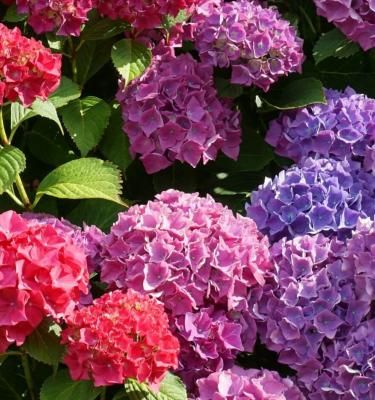

The Ultimate Guide to Hydrangeas Care
Hydrangeas (Hydrangea macrophylla) are the perfect flowering shrub for part shade AND their big blousy flower heads provide long-lasting colour from late spring and right throughout summer.
Hydrangeas lose their leaves in autumn or early winter and grow best in temperate and cool climates with warm dry summers and cool winters. Depending on the cultivar you’ve chosen, many hydrangeas flowers will also change colour depending on the soil pH and, yes you can alter the soil pH to change the flower's colour. Acidic soil will encourage blue flowers, alkaline soil will bring out pink flowers, while most white hydrangeas will remain white regardless of the soil pH.
4 top tips for growing hydrangeas
- Choose a semi or part-shade position, protected from the hot afternoon sun.
- Hydrangeas need regular watering during warm weather for the best and biggest flowers
- Hydrangeas are hungry plants, improve the soil with compost before planting and fertilise regularly with a liquid or controlled-release fertiliser
- Prune in winter, taking care not to remove stems that have NOT yet flowered, as they’ll produce the blooms for the coming season.
Essential shopping list for growing hydrangeas
- Hydrangea plant
- Scotts Osmocote Compost Premium Soil Improver
- Scotts Osmocote® Controlled Release Fertiliser: All Purpose
- Garden Shovel
- If growing in pots, you’ll need Scotts Osmocote® Premium Potting Mix + Scotts Osmocote Controlled Release Fertiliser for Pots, Planters and a suitable pot or container
- Defender Pyrethrum Insect Spray
- Mulch
- Scotts Osmocote® Seed & Cutting Potting Mix
- For blue hydrangeas fertilise with Scotts Osmocote® Plus Organics Roses, Gardenias & Azaleas Plant Food & Soil Improver
Preparation & planting hydrangeas in the garden
Hydrangeas require a semi or part shaded position, that’s protected from strong winds and hot afternoon sun. They also like a free-draining, yet moist soil.
The planting hole should be twice as wide as the original pot and the same depth. Fluff up the soil at the bottom of the hole and mix a little Scotts Osmocote Compost Premium Soil Improver through the original soil at the bottom of the planting hole.
Gently remove the hydrangea from the nursery pot and tease the roots lightly if they are compact. Plant into the prepared hole and backfill around the plant. Water in well. Once the plant shows signs of new growth, fertilise it with Scotts Osmocote® Controlled Release Fertiliser: All Purpose every 6 months.
Growing hydrangeas from cuttings
Softwood cuttings of hydrangeas can be taken in spring or early summer.
- Take a 10cm cutting from the growing tip of a stem no thicker than a pencil.
- Dip the cut end into hormone rooting powder or gel and stick the cutting into a pot filled with Scotts Osmocote® Seed & Cutting Potting Mix.
- Keep the potted cuttings moist, in a warm shaded spot until they strike roots.
- Transplant them to larger pots or your garden once they’ve developed roots and new growth.
Can hydrangeas grow in pots
Hydrangea can be grown in large pots or planters with good drainage - choose a pot that is at least 50cm deep and about the same width.
Fill your pot or planter with Scotts Osmocote® Premium Potting Mix. Gently remove the hydrangea from the nursery pot and tease the roots lightly if they are compact. Plant the hydrangea into the potting mix and backfill around the plant. Water in well. Once the plant shows signs of new growth, fertilise every 6 months with Scotts Osmocote® Controlled Release Fertiliser: All Purpose.
When to fertilise & how to care for hydrangeas
Hydrangea are hungry plants, they will need fertilising once every 6 months in late winter and again in summer with Scotts Osmocote® Controlled Release Fertiliser: All Purpose.
Prune hydrangeas after they’ve finished flowering in autumn or early winter. Do not cut back any stems that did not flower this year, they will be the stems to produce flowers over the coming winter. When pruning remove any dead, diseased or damaged growth.
To encourage pink or pale pink hydrangea blooms use a pH test kit to check the soil pH. Adjust the soil pH to be alkaline (pH 7 - 8.5) using a lime or dolomite lime product.
To encourage blue hydrangea blooms the soil needs to be acidic (pH 4.5 - 5.5) adjust it using a sulphur or fertilise with an acidic plant food like Scotts Osmocote® Plus Organics Roses, Gardenias & Azaleas Plant Food & Soil Improver.
Remember that some white hydrangeas won’t change colour at all - check the label when you purchase it to be sure.
Hydrangeas will need a twice-weekly deep watering throughout spring and summer, if they dry out their flowers will fail or dry off. Help retain moisture around the plants by using an open organic mulch around your hydrangeas.
Common hydrangeas pests & diseases
If fungal diseases occur on your hydrangeas, it could be because of high humidity - remove lower branches to open up the plants and improve airflow.
Whitefly, aphids and scale can sometimes cause a problem on hydrangeas - spray any infestations with Defender Pyrethrum Insect Spray if needed.




